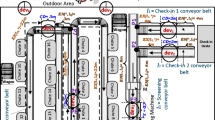Abstract
With the rise of moving object databases it is possible to store and process spatial and temporal data, for example geometrical structures together with the information about how these behave over intervals of time. For simple objects like moving points the spatiotemporal development is derived from the start and end position in space and time, which is then linearly interpolated. For moving regions, especially with changing shapes, it is more challenging to obtain the necessary data to represent them. An elegant and intuitive solution is to create an algorithm, which automatically interpolates the moving region from the start and end shape over a specified time interval. Two papers on this topic have been published in the past, each focussing on different aspects of this so-called Region Interpolation Problem. This paper tries to combine the advantages and improve these approaches to provide high-quality interpolations while maintaining robustness even in border cases. This results in the implementation of a library, which can be easily integrated into existing moving objects database systems, as for example the DBMS Secondo developed at the FernUniversität in Hagen.






















Similar content being viewed by others
Notes
These can be calculated by, e.g. the Graham Scan as described in [5].
O(n log n) with n as the number of segments of both faces.
http://dna.fernuni-hagen.de/secondo/. For more information, see also [3].
References
Forlizzi L, Güting RH, Nardelli E, Schneider M (2000) A data model and data structures for moving objects databases. In: Chen W, Naughton JF, Bernstein PA (eds) SIGMOD Conference. ACM, pp 319–330
Fournier A, Montuno DY (1984) Triangulating simple polygons and equivalent problems. ACM Trans Graph 3(2):153–174
Güting RH, Behr T, Düntgen C (2010) Secondo: a platform for moving objects database research and for publishing and integrating research implementations. IEEE Data Eng Bull 33(2):56–63
Güting RH, Behr T, Düntgen C (2013) Trajectory databases. In: Renso C, Spaccapietra S, Zimanyi E (eds) Mobility data: modeling, management, and understanding, chapter 3. Cambridge Press, pp 42–61
Graham RL (1972) An efficient algorithm for determining the convex hull of a finite planar set. Inf Process Lett 1(4):132–133
Gotsman C, Surazhsky V (2001) Guaranteed intersection-free polygon morphing. Comput Graph 25(1):67–75
Güting RH, Schneider M (2005) Moving objects databases. Morgan Kaufmann
Ierusalimschy R, de Figueiredo LH, Filho WC (1996) Lua-an extensible extension language. Softw Pract Exper 26(6):635–652
McMahon T, Thomas SL, Amato NM (2014) Sampling based motion planning with reachable volumes: application to manipulators and closed chain systems. In: 2014 IEEE/RSJ International Conference on Intelligent Robots and Systems, Chicago, IL, USA, September 14-18, 2014. IEEE, pp 3705–3712
McMahon T, Thomas SL, Amato NM (2014) Sampling-based motion planning with reachable volumes: theoretical foundations. In: 2014 IEEE International Conference on Robotics and Automation, ICRA 2014, Hong Kong, China, May 31 – June 7, 2014. IEEE, pp 6514–6521
McKenney M, Webb J (2010) Extracting moving regions from spatial data. In: Agrawal D, Zhang P, El Abbadi A, Mokbel MF (eds) GIS. ACM, pp 438–441
Tøssebro E, Güting RH (2001) Creating representations for continuously moving regions from observations. In: Jensen CS, Schneider M, Seeger B, Tsotras VJ (eds) SSTD, volume 2121 of Lecture Notes in Computer Science. Springer, pp 321–344
Yang W, Feng J (2009) 2d shape morphing via automatic feature matching and hierarchical interpolation. Comput Graph 33(3):414–423
Author information
Authors and Affiliations
Corresponding author
Appendix
Appendix


Rights and permissions
About this article
Cite this article
Heinz, F., Güting, R.H. Robust high-quality interpolation of regions to moving regions. Geoinformatica 20, 385–413 (2016). https://doi.org/10.1007/s10707-015-0240-z
Received:
Revised:
Accepted:
Published:
Issue Date:
DOI: https://doi.org/10.1007/s10707-015-0240-z




